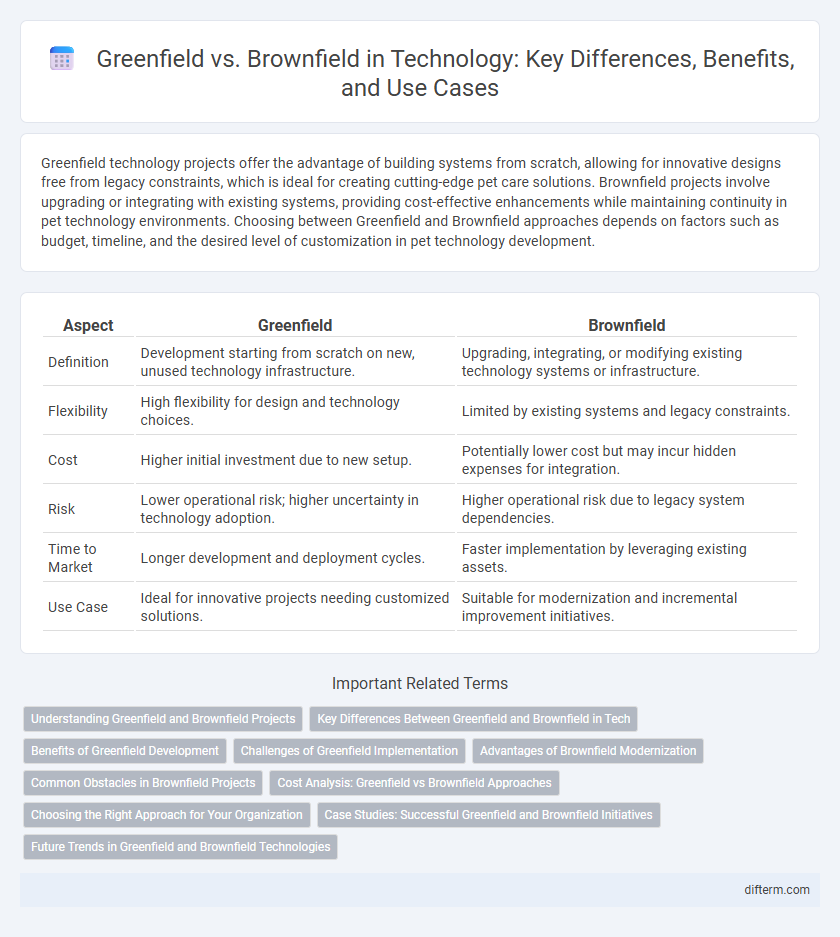Greenfield technology projects offer the advantage of building systems from scratch, allowing for innovative designs free from legacy constraints, which is ideal for creating cutting-edge pet care solutions. Brownfield projects involve upgrading or integrating with existing systems, providing cost-effective enhancements while maintaining continuity in pet technology environments. Choosing between Greenfield and Brownfield approaches depends on factors such as budget, timeline, and the desired level of customization in pet technology development.
Table of Comparison
| Aspect | Greenfield | Brownfield |
|---|---|---|
| Definition | Development starting from scratch on new, unused technology infrastructure. | Upgrading, integrating, or modifying existing technology systems or infrastructure. |
| Flexibility | High flexibility for design and technology choices. | Limited by existing systems and legacy constraints. |
| Cost | Higher initial investment due to new setup. | Potentially lower cost but may incur hidden expenses for integration. |
| Risk | Lower operational risk; higher uncertainty in technology adoption. | Higher operational risk due to legacy system dependencies. |
| Time to Market | Longer development and deployment cycles. | Faster implementation by leveraging existing assets. |
| Use Case | Ideal for innovative projects needing customized solutions. | Suitable for modernization and incremental improvement initiatives. |
Understanding Greenfield and Brownfield Projects
Greenfield projects involve creating new infrastructure or systems from scratch, allowing full customization and adoption of the latest technologies without legacy constraints. Brownfield projects require upgrading or integrating with existing systems, often facing challenges related to compatibility, legacy data, and incremental innovation. Understanding the scope, risks, and resource allocation in Greenfield versus Brownfield projects is crucial for effective technology strategy and decision-making.
Key Differences Between Greenfield and Brownfield in Tech
Greenfield projects involve developing new technology systems or infrastructure from scratch, allowing for complete customization and the use of the latest technologies without legacy constraints. Brownfield projects require integrating or upgrading existing systems, which often involves addressing compatibility issues, legacy software, and infrastructure limitations. Key differences include project scope, with greenfield offering flexibility and innovation potential, while brownfield emphasizes optimization and risk mitigation within established environments.
Benefits of Greenfield Development
Greenfield development offers the advantage of designing and building technology systems from scratch, enabling full customization to meet specific business needs without legacy constraints. It fosters innovation by allowing the integration of the latest technologies and architectures, resulting in optimized performance and scalability. The absence of previous infrastructure reduces technical debt and enhances system reliability and security.
Challenges of Greenfield Implementation
Greenfield implementation faces challenges such as higher initial costs and extended timelines due to the need for building infrastructure from scratch. It requires significant resource allocation, including skilled personnel and advanced planning to mitigate risks associated with untested environments. Integration complexities arise as seamless compatibility with existing systems must be established without prior frameworks or legacy constraints.
Advantages of Brownfield Modernization
Brownfield modernization leverages existing infrastructure, reducing costs and project timelines while minimizing environmental impact through the reuse of materials and facilities. This approach allows seamless integration with current systems, enhancing operational efficiency and maintaining business continuity during upgrades. Companies benefit from quicker deployment and decreased regulatory hurdles compared to greenfield projects, optimizing resource utilization in technology transformation.
Common Obstacles in Brownfield Projects
Brownfield projects often face challenges such as legacy system integration, which complicates seamless data migration and compatibility with new technologies. Regulatory compliance and environmental remediation can significantly increase project timelines and costs, particularly when dealing with outdated infrastructure. Limited documentation and unknown variables in existing systems create risks that slow down development and increase uncertainty in project outcomes.
Cost Analysis: Greenfield vs Brownfield Approaches
Cost analysis of Greenfield projects often requires higher initial capital investment due to land acquisition, infrastructure development, and technology deployment from scratch. Brownfield projects typically benefit from lower upfront costs by leveraging existing structures and utilities but may incur additional expenses for renovation, compliance, and integration with legacy systems. Evaluating total cost of ownership for Greenfield versus Brownfield approaches demands consideration of long-term operational efficiency, scalability, and potential risk factors associated with each development strategy.
Choosing the Right Approach for Your Organization
Selecting the right approach between Greenfield and Brownfield projects depends on organizational goals, budget constraints, and existing infrastructure. Greenfield offers complete freedom to design new systems from scratch, ideal for companies aiming to innovate without legacy limitations. Brownfield leverages and upgrades existing systems, reducing costs and time while minimizing disruption, making it suitable for organizations seeking gradual transformation.
Case Studies: Successful Greenfield and Brownfield Initiatives
Case studies reveal that Greenfield projects, such as Amazon Web Services' initial cloud infrastructure, enable innovation through building systems from scratch with cutting-edge technologies. In contrast, Brownfield initiatives like IBM's modernization of legacy systems demonstrate efficient integration of new solutions within existing frameworks, reducing risk and cost. Successful technology implementations balance scalability and adaptability, leveraging tailored strategies according to project constraints and organizational goals.
Future Trends in Greenfield and Brownfield Technologies
Future trends in Greenfield technologies emphasize the integration of AI-driven automation, blockchain for enhanced security, and renewable energy solutions to create completely new, scalable infrastructures. Brownfield developments focus on innovative retrofitting techniques, edge computing integration, and IoT-enabled modernization to optimize and extend the lifespan of existing systems. Both approaches leverage advancements in 5G connectivity and digital twins to drive efficiency and sustainability in evolving tech landscapes.
Greenfield vs Brownfield Infographic

 difterm.com
difterm.com